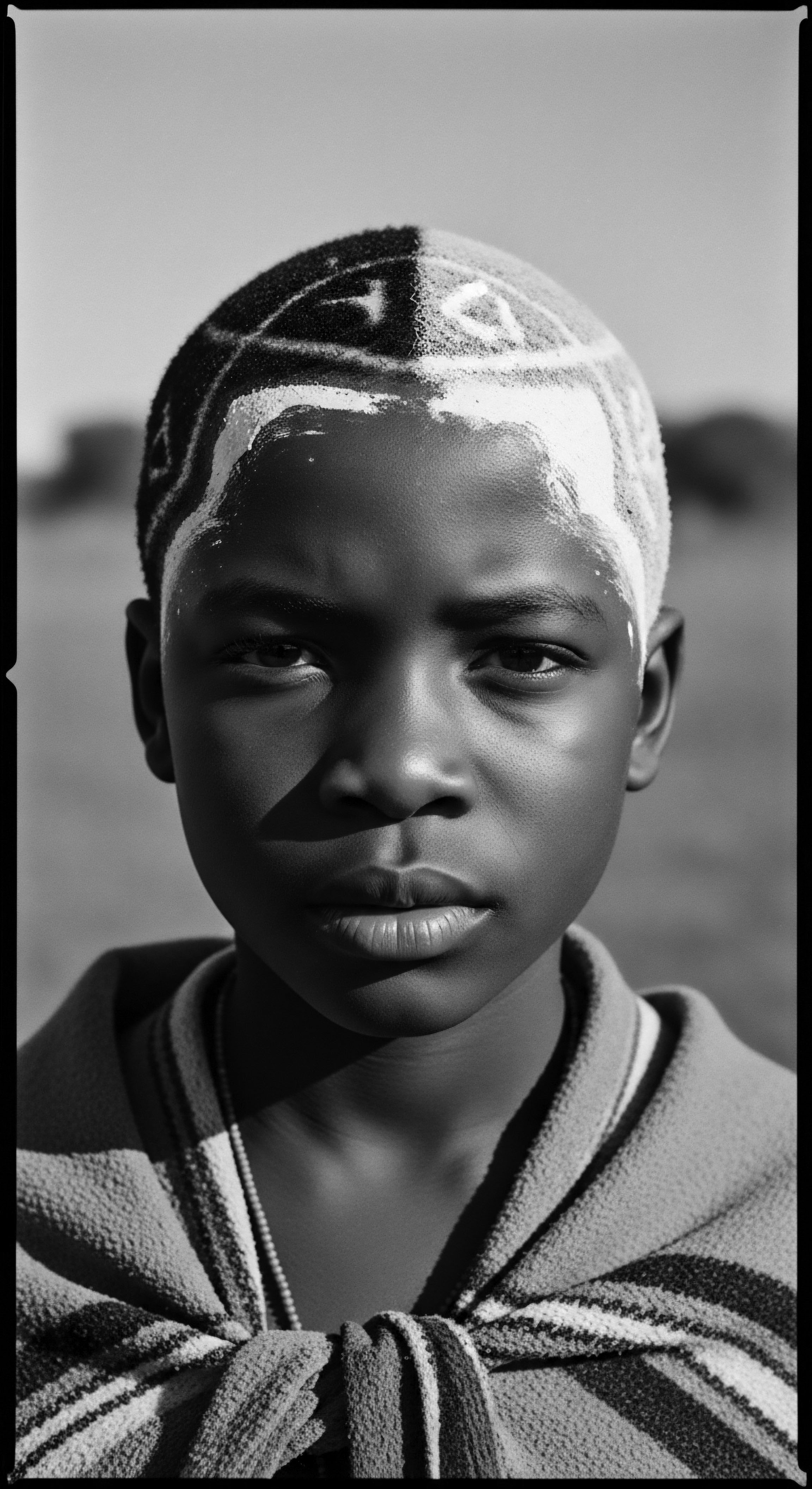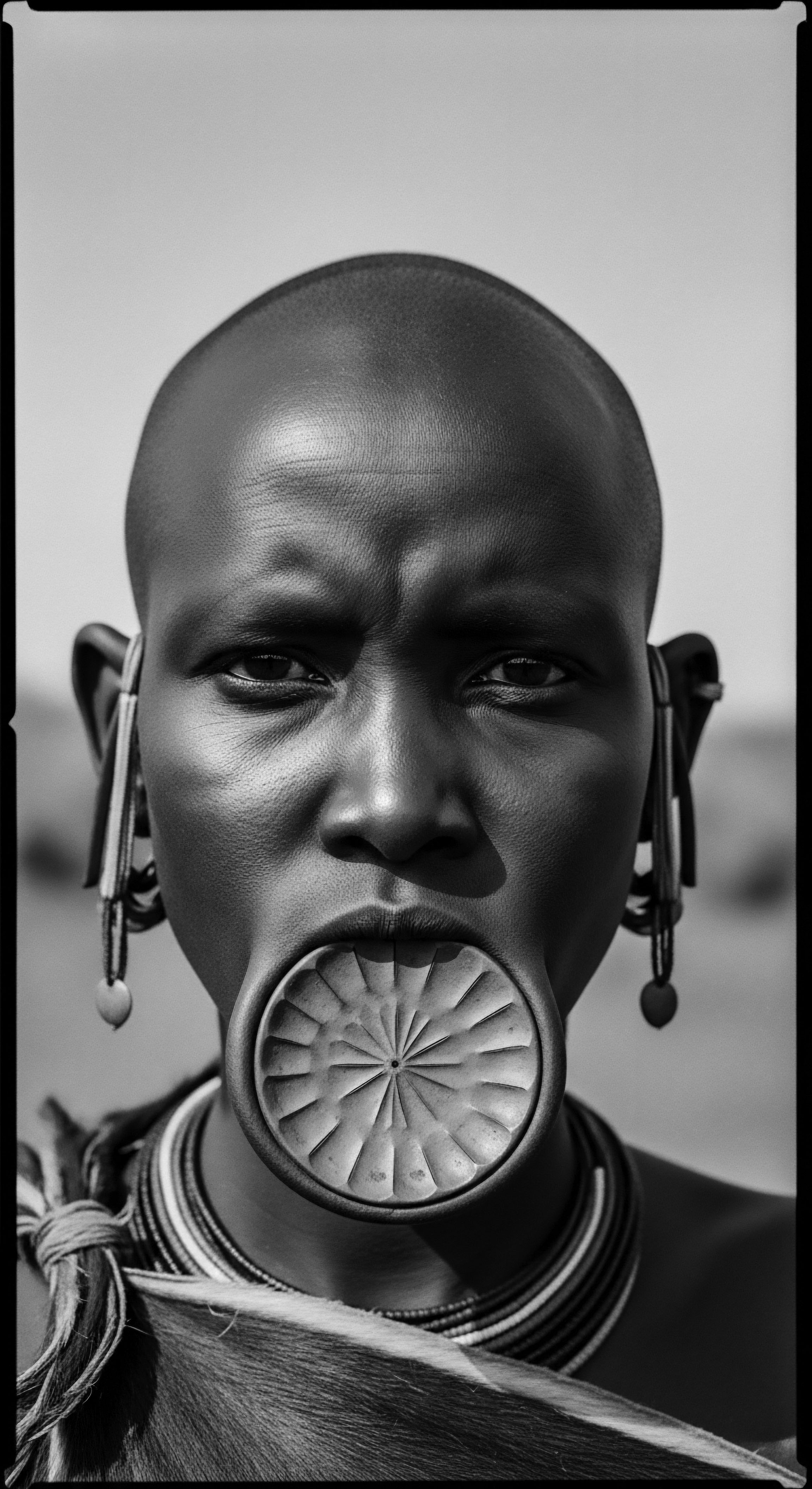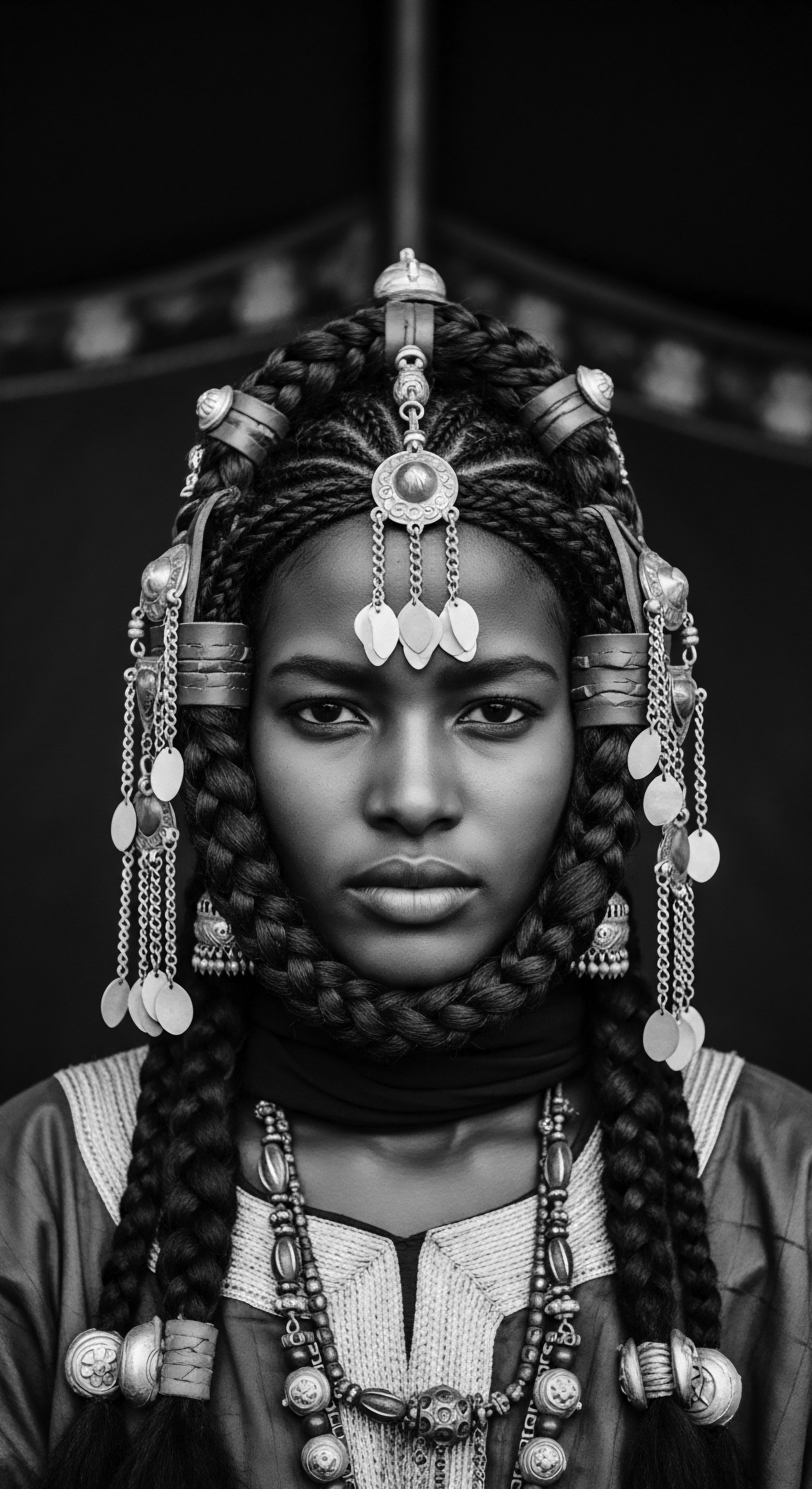
Roots
Consider, for a moment, the very strands that spring from a scalp, each a testament to life’s persistent emergence. For those with textured hair, this connection extends beyond the individual, reaching back through epochs, touching the hands that once sculpted, tended, and understood hair as a living chronicle. Our journey into how early braiding patterns conveyed heritage begins here, at this elemental root, where the very biology of our hair intertwined with ancient ways of knowing and being. This profound lineage, often overlooked in standard histories, holds within its coils the wisdom of generations who saw hair as a sacred, communicative medium.
The unique helices of textured hair, with their inherent curl and varying porosity, offered a canvas unlike any other. Early communities across Africa, long before recorded histories, recognized these qualities. They understood the nuances of each strand, its strength, its natural inclination to bind and coil.
This intimate understanding shaped not only how hair was cared for but how it became a language, a dynamic system for sharing vital information within a group. The physical characteristics of hair, its structure and response to manipulation, guided the forms that communication would take.

Ancient Anatomies, Ancestral Lexicons
Hair anatomy, viewed through ancestral eyes, was never a mere biological detail. It was part of a holistic cosmology. The very act of styling, of partitioning the scalp and forming segments of hair into designs, became a practice of mapping identity and social geography onto the body.
The varied classifications we sometimes use today for textured hair—from loose curls to tight coils—find echoes in ancient understandings, where different hair types might have suggested familial lines or regional affiliations. There was an intuitive science at play, a deep comprehension of the hair’s inherent properties and how they influenced the longevity and meaning of a style.
Braiding patterns in early societies were a foundational language, reflecting a collective wisdom of hair’s innate properties and its place in communal life.
The initial lexicon surrounding textured hair was not codified in texts but rather in shared practices and communal observation. Terms, passed orally, would describe not only the style but the occasion, the person’s status, or the message intended. For instance, specific partings could denote marital status, while the direction of a braid might indicate tribal origin.
This embodied knowledge, transmitted from elder to youth through touch and teaching, laid the groundwork for complex communication systems. Each segment of a braid, each curve against the scalp, became a word in a silent, yet powerful, ancestral tongue.
- Scalp Partitioning ❉ The division of hair into sections was often the first step in creating symbolic designs.
- Coil Density ❉ Hair’s natural curl pattern influenced style choices, with denser coils lending themselves to certain protective forms.
- Strand Integrity ❉ Understanding hair’s strength and elasticity guided the tension applied during braiding, ensuring longevity and comfort.
The earliest depictions of braided hair, dating back as far as 3500 BCE in ancient Egypt, hint at these foundational connections. These images show not just decorative styles but purposeful arrangements that spoke volumes without uttering a sound. The archaeological evidence suggests that communities held hair stylists in high esteem, recognizing their skill not merely as aesthetic artistry but as a conduit for social and spiritual expression.

Ritual
Beyond foundational understanding, the act of braiding itself was a ritual, a tender thread connecting generations and shaping communal bonds. The styling of textured hair, particularly in early African societies, transcended mere beautification; it was a living practice, a communal ceremony that transferred not only aesthetic skill but ancestral stories, warnings, and collective memory. These sessions, often spanning hours, became spaces of shared intimacy, where hands working on hair also massaged away worries and built enduring connections. This shared endeavor was as vital as the final design.

Communal Crafting, Shared Histories
The art of styling textured hair historically involved a wealth of techniques, from simple plaiting to intricate cornrow designs that lay flat against the scalp. These methods, honed over millennia, were not randomly chosen. Each technique served a purpose, often related to practicality, status, or a specific message.
Young girls would learn from their mothers, aunts, and grandmothers, mimicking movements, feeling the texture of the hair, and absorbing the silent lessons of resilience and care. The rhythmic pulling and twisting became a physical meditation, a link to those who came before.
Traditional tools, though simple, were extensions of this craft. Combs carved from wood or bone, pins crafted from natural materials, and even the skilled fingers themselves were all part of the sacred toolkit. These instruments, often imbued with symbolic meaning, were handled with reverence.
They were conduits for ancestral knowledge, shaping the hair while simultaneously shaping identity. The choices made in styling — the number of braids, their thickness, the direction they flowed — all held layers of meaning, reflecting a sophisticated visual language.
Braiding was a communal rite, fostering connections and passing down generational wisdom through the gentle touch of hands on hair.

Transformations and Protective Powers
Many early braiding patterns served as protective styles, shielding the scalp and hair from harsh environmental elements while promoting healthy growth. This practical aspect was deeply intertwined with spiritual and social considerations. A style might protect the wearer from the sun’s intensity and simultaneously declare their age group or eligibility for marriage. The transformation achieved through braiding was both physical and symbolic, preparing individuals for rites of passage, ceremonies, or simply the rigors of daily life.
Consider, for example, the Himba people of Namibia. Their practice involves creating elaborate braids, often coated with a mixture of red ochre paste, butter, and aromatic resins. This distinct styling is not merely cosmetic; it protects the hair and scalp from the arid climate while also serving as a visual indicator of age, marital status, and social standing within the community.
Girls begin with two plaits that signify childhood, transitioning to more numerous and elaborate dreadlocked styles after puberty, marking their journey into womanhood and readiness for new life stages (OkayAfrica, 2023). This centuries-old practice showcases how styles could transmit complex personal information.
| Community or Region Yoruba (Nigeria) |
| Distinctive Braiding Practice Irun Kiko (thread-wrapped styles) |
| Communicated Heritage Aspect Femininity, marital status, coming-of-age rites, spiritual connection |
| Community or Region Fulani (West Africa) |
| Distinctive Braiding Practice Five long braids, often with beads, cowrie shells |
| Communicated Heritage Aspect Wealth, status, marital status, tribal affiliation, |
| Community or Region Himba (Namibia) |
| Distinctive Braiding Practice Ochre-coated dreadlocks, varying plaits for age |
| Communicated Heritage Aspect Age, marital status, connection to earth and ancestors, |
| Community or Region Ashanti (Ghana) |
| Distinctive Braiding Practice Adinkra symbols incorporated into styles |
| Communicated Heritage Aspect Specific messages, proverbs, wisdom, unity |
| Community or Region These styles represent a fraction of the diverse ways hair communicated identity and shared history across the African continent. |
The time investment in these styles was also part of their cultural value. Braiding sessions could span days, particularly for elaborate ceremonial coiffures. This dedication underscored the significance of the hair’s role in public life and personal identity. The shared space and time fostered storytelling, mentorship, and the silent transmission of cultural norms, cementing the bond between the stylist, the wearer, and their collective heritage.

Relay
The historical journey of braiding patterns extends beyond their aesthetic and social functions, serving as powerful conduits for vital information, particularly through times of profound adversity. Early braiding patterns, in their deepest iteration, acted as a visual language, a system of signs understood by those within a community. This silent lexicon enabled groups to transmit complex data—from social status and spiritual allegiance to practical directions for survival. The ingenuity embedded within these patterns speaks to a sophisticated form of communication, adapted and preserved even in the face of attempts to dismantle cultural ties.

Silent Signals for Survival
During the transatlantic slave trade, as millions of Africans were forcibly removed from their homelands, their traditional hair practices were met with brutality and attempts at erasure. Stripped of their languages and cultural expressions, enslaved Africans found ways to preserve their heritage through clandestine means. Hair, a portable and intrinsic aspect of identity, became a secret archive. Cornrows, with their tight, flat patterns against the scalp, emerged as a particularly profound vehicle for covert communication.
In a remarkable testament to human resilience, enslaved individuals ingeniously utilized cornrow patterns to create maps and convey escape routes. For instance, in regions such as Colombia, historical accounts reveal instances where cornrow designs were meticulously fashioned to mimic the winding paths and geographical landmarks of the surrounding terrain, offering visual guides for those seeking freedom (Copyright, 2022). Specific patterns might indicate rivers, mountains, or safe houses, silently directing individuals along the perilous paths of the Underground Railroad. This was not mere symbolism; it was actionable intelligence, a lifeline braided into being.
During the era of enslavement, specific cornrow patterns served as hidden maps, silently guiding individuals toward freedom.
Beyond navigation, these patterns also concealed sustenance. Enslaved African women, anticipating the brutal Middle Passage journey, would sometimes braid rice, seeds, or grains into their own hair or their children’s hair. This desperate act provided a meager, yet vital, source of food for survival in the dire conditions of the slave ships and the new, alien lands (BLAM UK CIC, 2022). This practical application underscores the dual nature of these hair forms ❉ deeply cultural and absolutely essential for existence.

Hair as a Living Archive
The communication inherent in early braiding patterns transcends immediate survival. It also communicated a continuity of self, a refusal to abandon one’s origins. Each pattern, each style, served as a living archive of a people’s history, their values, and their collective identity. Even when overt cultural expression was suppressed, the memory held within hair, and the traditions of its styling, persisted.
Scholars like Ron Eglash, a University of Michigan professor, have explored how indigenous concepts of recursion found in West and Central African design practices—including cornrows—relate to fractal geometry. He suggests these are “heritage algorithms,” complex systems of knowledge passed down through generations, demonstrating a sophisticated understanding of patterns and their ability to encode information (U-M Stamps, 2021).
This cultural intelligence, passed from hand to hand, generation to generation, maintained connections across vast distances and through immense historical ruptures. The styles, even when adapted, carried a whisper of the ancestral land, a visual declaration of belonging to a shared heritage.
- Social Status ❉ From royalty to commoner, braids could indicate a person’s rank, wealth, or influence within their society,
- Age and Life Stages ❉ Specific styles marked transitions from childhood to adolescence, marriage, or elder status,
- Tribal or Familial Affiliation ❉ Distinct patterns served as identifiers, allowing recognition of one’s group or family lineage,
- Spiritual or Religious Beliefs ❉ Certain styles were associated with deities, rituals, or served as protective amulets,
The historical journey of these communication systems, from pre-colonial expressions of identity to silent acts of resistance during enslavement, underscores the enduring power of textured hair as a medium for heritage. It speaks to a profound cultural literacy, where a glance at a head of braided hair could disclose a wealth of information, a language understood and protected by those who lived it.

Reflection
The enduring legacy of braiding patterns, stretching back to ancient rhythms, continues to sing through the living strands of textured hair. It stands as a profound testament to ingenuity, adaptation, and an unwavering spirit. The wisdom held within each bend and twist of a curl, each partition of the scalp, serves as a bridge, connecting present moments to ancestral echoes. This deep appreciation for hair is not merely an academic exercise; it is an invitation to feel the pulse of history within oneself, to recognize the countless hands that have touched, tended, and transformed this part of our being.
The “Soul of a Strand” is indeed a living archive, breathing through every unique style and shared moment of care. It compels us to understand that our hair is more than a biological extension; it is a repository of collective experience, a silent storyteller of resilience, defiance, and beauty. To care for textured hair with intention is to engage in a continuous conversation with this ancestral wisdom, to honor the historical narratives etched into its very form. It allows us to recognize that the art of braiding, born of necessity and elevated to cultural expression, remains a powerful declaration of identity and a vibrant connection to a rich, unfolding heritage.

References
- Byrd, Ayana, and Lori L. Tharps. Hair Story ❉ Untangling the Roots of Black Hair in America. St. Martin’s Press, 2001.
- Dabiri, Emma. Twisted ❉ The Tangled History of Black Hair Culture. Harper Perennial, 2020.
- Eglash, Ron. African Fractals ❉ Modern Computing and Indigenous Design. Rutgers University Press, 1999.
- Jacobs-Huey, Lanita. From the Kitchen to the Parlor ❉ Language and Becoming in African American Women’s Hair Care. Oxford University Press, 2006.
- Lupin, M. “Traditional Braiding Practices Across Africa.” International Journal of Trichology, 2015.
- Sherrow, Victoria. Encyclopedia of Hair ❉ A Cultural History, 2nd Edition. Greenwood, 2023.
- Vermeer, C. & Apeldoorn, V. “Hair Practices in African Tribes.” Journal of Anthropological Studies, 2014.
